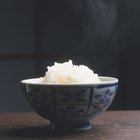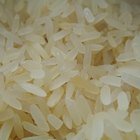
Rice that isn't cooked, cooled or reheated properly can make you sick. Bacillus cereus, a type of bacteria, can live on uncooked grains of rice. Cooking rice doesn't kill the bacteria. If cooked rice is left to sit at room temperature for long periods, the bacteria can release toxins, which multiply and can lead to food poisoning.
Cooking
Using a rice cooker is a convenient and safe way to prepare rice. You don't have to worry about burning the rice on the stove top. Once the rice is cooked, most cookers will switch to warming mode and should keep the rice at a temperature of 135 degrees Fahrenheit, which is a safe temperature. You can also cook rice on the stove top by combining 1 part white rice with 1 1/2 parts of water, then bringing it to a boil. Reduce the heat to a simmer and cook until the rice absorbs the water. The rice should be steaming and hot throughout. Serve the rice right away.
Cooling
Cooling leftover rice quickly reduces the chance the bacteria will produce toxins. When the rice is between 41 and 135 F, bacteria reproduce and spread more quickly. To quickly cool rice, divide it into 1/2- to 1-cup portions and place each portion in a shallow container. Cover the containers and place them in your refrigerator. Another way to cool rice quickly is to place a larger container in a bowl of ice water. Don't let the water get on the rice, though. For safety, the rice needs to reach 40 F or cooler within four hours.
Storing
Keep cooked rice in your refrigerator until you are ready to reheat it. In the refrigerator, white rice can keep for four to six days, although it's always best to use food as quickly as possible. Another way to safely store rice is to freeze it. In a freezer that is at 0 F, rice can keep indefinitely, although its flavor and quality start to wane after about six months.
Reheating
You can reheat rice in the microwave or oven, or in a frying pan if you are using it to make fried rice. Heat the leftover rice to a temperature of at least 165 F. Only reheat rice that has been cooled quickly and stored properly. You can't see, taste or smell signs of contamination, so you have no way to know if the rice is safe to eat unless you've taken care to cool and store it correctly. It is better to be on the safe side and throw out any rice you've left out for more than an hour. Do not reheat rice more than once.
Related Articles

How to Store Rice

How to Cook Japanese Rice

How Long After a Sell-By Date Can You ...

How to Remove Starch From Rice

How to Cook Rice in a Steamer

Brown Basmati Rice Cooking Directions

How to Make Sushi Rice With Vinegar

How to Cook Rice in Foil

How to Cook Steamed Rice With a Bamboo ...

For How Long Does Boxed Dry Rice Last?

How to Re-Heat Cooked Rice

How to Cook Long Grain Rice

How to Cook Red Camargue Rice

How to Make Sticky Rice Recipe

How to Cook Golden Rose Rice

How Long Can I Store Uncooked Jasmine ...

How to Dry Out Sticky Rice
The Best Pot to Cook Rice

How to Boil Rice

How to Cook Brown Basmati Rice
References
Writer Bio
Based in Pennsylvania, Emily Weller has been writing professionally since 2007, when she began writing theater reviews Off-Off Broadway productions. Since then, she has written for TheNest, ModernMom and Rhode Island Home and Design magazine, among others. Weller attended CUNY/Brooklyn college and Temple University.
Photo Credits
NA/Photos.com/Getty Images